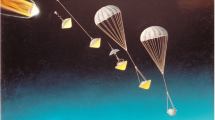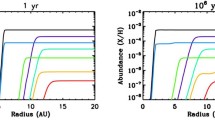Abstract
For the Ice Giants, atmospheric entry probes provide critical measurements not attainable via remote observations. Including the 2013–2022 NASA Planetary Decadal Survey, there have been at least five comprehensive atmospheric probe engineering design studies performed in recent years by NASA and ESA. International science definition teams have assessed the science requirements, and each recommended similar measurements and payloads to meet science goals with current instrument technology. The probe system concept has matured and converged on general design parameters that indicate the probe would include a 1-meter class aeroshell and have a mass around 350 to 400-kg. Probe battery sizes vary, depending on the duration of a post-release coast phase, and assumptions about heaters and instrument power needs. The various mission concepts demonstrate the need for advanced power and thermal protection system development. The many completed studies show an Ice Giant mission with an in situ probe is feasible and would be welcomed by the international science community.


Similar content being viewed by others
Notes
References
Aplin et al., Atmospheric electricity at the ice giants (this issue)
C.S. Arridge, C.B. Agnor, N. André, K.H. Baines, L.N. Fletcher, D. Gautier et al., Uranus Pathfinder: exploring the origins and evolution of Ice Giant planets. Exp. Astron. 33, 753 (2012). https://doi.org/10.1007/s10686-011-9251-4
C.S. Arridge, N. Achilleos, J. Agarwal, C.B. Agnor, R. Ambrosi, N. André et al., The science case for an orbital mission to Uranus: exploring the origins and evolution of ice giant planets. Planet. Space Sci. 104, 122 (2014). https://doi.org/10.1016/j.pss.2014.08.009
Aslam et al., Advanced net flux radiometer focal plane assembly for ice giants (this issue)
S. Atreya, A. Crida, T. Guillot, J. Lunine, N. Madhusudhan, O. Mousis, The origin and evolution of Saturn, with exoplanet perspective, in Saturn in the 21st Century (Cambridge Planetary Science), ed. by K. Baines, F. Flasar, N. Krupp, T. Stallard (Cambridge University Press, Cambridge, 2018), pp. 5–43. https://doi.org/10.1017/9781316227220.002
Atreya et al., Deep atmosphere composition, structure. origin, and entry probes (this issue)
Atkinson et al., Model payload for ice giant entry probe missions. (this issue)
D. Banfield, A. Simon, R. Danner, D.H. Atkinson, K.R. Reh, SPRITE: a Saturn probe new frontiers mission, in 2018 IEEE Aerospace Conference, Big Sky, MT, 2018 (2018), pp. 1–15. https://doi.org/10.1109/AERO.2018.8396829
W.J. Borucki et al., Characteristics of planetary candidates observed by Kepler, II: analysis of the first four months of data. Astrophys. J. 736, 19 (2011)
Cavalié et al., The deep composition of Uranus and Neptune from in situ exploration and thermochemical modeling. (this issue)
L.A. D’Amario, L.E. Bright, A.A. Wolf, Galileo trajectory design. Space Sci. Rev. 60, 23–78 (1992)
M.J. Duncan, J.J. Lissauer, Orbital stability of the Uranian satellite system. Icarus 125, 1–12 (1997)
Ferri et al., The atmospheric structure of the ice giants planets from in situ measurements. (this issue)
L. Fletcher, N. Andre, D. Andrews, M. Bannister, E. Bunce et al., Ice Giant Systems: The Scientific Potential of Missions to the Uranus and Neptune Systems (ESA Voyage 2050 White Paper) (2019). arXiv:1907.02963
Fletcher et al., Meridional circulation patterns on the Ice Giants inferred from remote sensing and implications for probe entry site selection. (this issue)
O. Grasset, M.K. Dougherty, A. Coustenis, E.J. Bunce, C. Erd, D. Titov et al., Jupiter icy moons explorer (JUICE): an ESA mission to orbit Ganymede and to characterise the Jupiter system. Planet. Space Sci. 78, 1 (2013). https://doi.org/10.1016/j.pss.2012.12.002
T. Guillot, The interiors of giant planets: models and outstanding questions. Annu. Rev. Earth Planet. Sci. 33, 493–530 (2005)
M. Hofstadter, A. Simon, S. Atreya, D. Banfield, J. Fortney, A. Hayes, M. Hedman, G. Hospodarsky, A. Masters, K. Mandt, M. Showalter, K. Soderlund, D. Turrini, E. Turtle, K. Reh, J. Elliott, N. Arora, A. Petropoulos, Uranus and Neptune missions: a study in advance of the next planetary science decadal survey. Planet. Space Sci. (2019). https://doi.org/10.1016/j.pss.2019.06.004
A.I. Hsu, M.H. Wong, A.A. Simon, Lifetimes and occurrence rates of dark vortices on Neptune from 25 years of Hubble Space Telescope images. Astron. J. 157, 152 (2019)
R. Hueso, A. Sánchez-Lavega, Atmospheric dynamics and vertical structure of Uranus and Neptune’s weather layers (2019, this issue). https://doi.org/10.1007/s11214-019-0618-6
P.G.J. Irwin, M.H. Wong, A.A. Simon, G.S. Orton, D. Toledo, HST/WFC3 observations of Uranus’ 2014 storm clouds and comparison with VLT/SINFONI and IRTF/Spex observations. Icarus 288, 99 (2017)
Y. Kaspi, J.E. Davighi, E. Galanti, W.B. Hubbard, The gravitational signature of internal flows in giant planets: comparing the thermal wind approach with barotropic potential-surface methods. Icarus 276, 170–181 (2016)
Mandt et al., Tracing the origins of the ice giants through noble gas abundances and isotopic composition (this issue)
A. Masters, N. Achilleos, C.B. Agnor, S. Campagnola, S. Charnoz, B. Christophe et al., Neptune and Triton: essential pieces of the Solar System puzzle. Planet. Space Sci. 104, 108 (2014). https://doi.org/10.1016/j.pss.2014.05.008
O. Mousis, L.N. Fletcher, J.-P. Lebreton, P. Wurz, T. Cavalié, A. Coustenis et al., Scientific rationale for Saturn’s in situ exploration. Planet. Space Sci. 104, 29 (2014). https://doi.org/10.1016/j.pss.2014.09.014
O. Mousis, D.H. Atkinson, T. Spilker, E. Venkatapathy, J. Poncy, R. Frampton et al., The Hera Saturn entry probe mission. Planet. Space Sci. 130, 80 (2016). https://doi.org/10.1016/j.pss.2015.06.020
O. Mousis, D.H. Atkinson, T. Cavalié, L.N. Fletcher, M.J. Amato, S. Aslam et al., Scientific rationale for Uranus and Neptune in situ explorations. Planet. Space Sci. 155, 12 (2018). https://doi.org/10.1016/j.pss.2017.10.005
Mousis et al., Key atmospheric signatures for identifying the source reservoirs of volatiles in Uranus and Neptune. (this issue)
C.C. Porco, P.D. Nicholson, J.N. Cuzzi, J.J. Lissauer, L.W. Esposito, Neptune’s ring system, in Neptune and Triton (1995), pp. 703–804
Renard et al., Counting and scattering function measurements to determine the physical properties of the aerosols in the ice giants atmospheres. (this issue)
L.A. Sromovsky, H.B. Hammel, I. de Pater, P.M. Fry, K.A. Rages, M.R. Showalter, W.J. Merline, P. Tamblyn, C. Neyman, J.-L. Margot, J. Fang, F. Colas, J.-L. Dauvergne, J.M. Gomez-Forrellad, R. Hueso, A. Sanchez-Lavega, T. Stallard, Episodic bright and dark spots on Uranus. Icarus 220, 6–22 (2012)
D. Turrini, R. Politi, R. Peron, D. Grassi, C. Plainaki, M. Barbieri et al., The comparative exploration of the ice giant planets with twin spacecraft: unveiling the history of our Solar System. Planet. Space Sci. 104, 93 (2014). https://doi.org/10.1016/j.pss.2014.09.005
Vorburger et al., Chemical and isotopic composition measurements. on atmospheric probes (this issue)
K. Zhang, D. Kong, G. Schubert, Thermal-gravitational wind equation for the wind-induced gravitational signature of giant gaseous planets: mathematical derivation, numerical method, and illustrative solutions. Astrophys. J. 806(2), 270 (2015)
Acknowledgements
Fletcher was supported by a Royal Society Research Fellowship and European Research Council Consolidator Grant (under the European Union’s Horizon 2020 research and innovation program, grant agreement No. 723890) at the University of Leicester. Masters was supported by a Royal Society University Research Fellowship. Mousis and Coustenis acknowledge support from CNES.
Author information
Authors and Affiliations
Corresponding author
Additional information
Publisher’s Note
Springer Nature remains neutral with regard to jurisdictional claims in published maps and institutional affiliations.
In Situ Exploration of the Ice Giants: Science and Technology
Edited by Olivier J. Mousis and David H. Atkinson
Rights and permissions
About this article
Cite this article
Simon, A.A., Fletcher, L.N., Arridge, C. et al. A Review of the in Situ Probe Designs from Recent Ice Giant Mission Concept Studies. Space Sci Rev 216, 17 (2020). https://doi.org/10.1007/s11214-020-0639-1
Received:
Accepted:
Published:
DOI: https://doi.org/10.1007/s11214-020-0639-1




